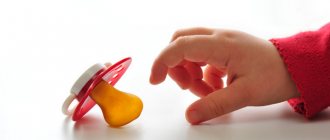Carefully bringing the child into the waiting home, at first you are ready to carry him in your arms for as long as necessary, as you carried him under your heart for nine months before birth. But the days pass, fatigue accumulates, and it begins to seem that the baby cannot wait for you in silence for even a second. Things are multiplying, I want to distract myself, relax. Suddenly it dawns on you: yes, apparently I’m spoiling him. Why is he mischievous, refuses to understand, and won’t let you do anything other than him? Therefore, the question of how to wean a child from holding hands is quite popular on various Internet forums and blogs.
How not to teach a child to hold hands?
CONTENT:
The baby was in continuous contact with his mother for nine long months, so for the first time after birth he is at a loss when separated from her for a long time. Being at a distance, the little one begins to cry.
A baby cannot be capricious simply because he wants to. For him, the presence of his mother makes him feel loved. This is important for physical development.
How to wean a child off your hands without harming him is not an easy task. Under pressure from the authority of relatives or due to being busy, mothers try to replace carrying in their arms with other options for interaction.
To do this you can try:
- Change tactile contact to visual or auditory (the baby, hearing his mother’s voice, can calm down);
- carry the baby in a sling (this will free up the parents’ hands, but the baby will feel safe);
- add bright colors to the baby’s life (rattles, educational mats, mobiles, pictures);
- take the baby in your arms, but in an uncomfortable position for him;
- do not react to crying (the baby will get bored and stop being capricious);
- Don’t let your little one sleep during a walk (he’ll get exhausted and fall asleep at home);
- play with your child “at a distance” (for example, in “Cook”).
The listed methods should be used when the problem of addiction has already arisen.
Why should you wean your child off your hands?
The real reasons for refusing to carry a child in your arms may be:
- Mom's workload with household chores. To eliminate the problem, it is enough to shift some of the tasks to your husband or relatives. They will be happy to look after the baby, and the child will have a rested mother.
- Physical or mental fatigue. It happens that women in labor suffer from postpartum depression or simply do not have time to complete the entire amount of work that has fallen on their shoulders. In this case, it is also recommended to seek the support of friends or loved ones.
- Back to work soon. If there is a lack of money, a woman is often forced to go to work prematurely. Then the child should be weaned in advance from constant carrying in his arms. It would be good to help him get used to a foreign environment at the same time.
The question “how to wean a child from holding hands” will disappear on its own after about six months or a year after the baby is born. At this age, toddlers get off their mother’s arms and try to actively explore the territory around them. At the same time, the first complementary foods are introduced, which shortens the duration of breastfeeding.
Cases in which it is not necessary to wean a child or should be postponed
Sometimes it’s worth holding off on experimenting with hand weaning. This long and complex process should be postponed when:
- The child is sick (really needs care at this time);
- tummy hurts or teething (mom’s presence brings relief);
- the baby is developing slowly (rehabilitation will require time and support);
- The toddler was born premature;
- parents changed their place of residence or went traveling (stability disappears).
Benefits of close contact between mother and newborn
The first months of a baby’s life are the most important period both for him and for young parents. The newborn actively adapts to a new and incomprehensible world, in which close contact with the mother helps very much.
Many experts call the first three months of a child’s life the “fourth trimester,” because despite the fact that he is no longer connected to his mother by the umbilical cord, the connection with her is still very strong. Hence the increased dependence on tactile contact. Rocking, stroking - all these manipulations let the baby know that he is safe and help in full development.
Being held in mother's arms has many benefits for a small child, for example:
- Close contact, carrying and breastfeeding actively stimulate the development of the cerebral cortex.
- Mother's stroking and touching have a beneficial effect on stimulating blood circulation, developing immunity and improving the nervous and endocrine systems.
- Carrying it in the mother's arms helps the child receive more information from the outside, which contributes to his intellectual development.
- Proper carrying in the arms helps improve the formation of the musculoskeletal system, hip joints and spinal column.
How to wean a child off your hands?
The success of the planned event largely depends on the age of the baby. It is believed that one-year-old children cannot, due to their level of development, be cunning and deceive. If a child of this age needs a hug from his mother, this is an absolute necessity. He will learn to lie later.
If the issue of weaning your toddler off your hands is resolved, you should at least follow some simple rules:
- You need to be patient;
- the baby should not be punished or scolded;
- the atmosphere in the house should be calm;
- tactile contact should be reduced gradually;
- help from relatives is welcome;
- toys will help distract the baby;
- you can't give up.
The age characteristics of children require different approaches to solving the issue.
Age, characteristics, period Recommendations
From 0 to 3 months
This period of baby development is called the “fourth trimester” of pregnancy, since the emotional and physical contact between mother and child is still very close. You should not categorically refuse hugs to your child. The main thing is that the baby does not form the habit of constantly being held in your arms.
In order to distract your baby from hugs, you can:
- put on a disc with a quiet melody;
- give a rattle;
- pet the tummy;
- massage your back.
It is recommended to pick up the child in case of emergency.
4 to 6 months
At this age, the baby begins to actively take an interest in the world around him. Getting your child interested becomes easier. You can offer him rattles or mobiles; play with him (for example, “Agu”, “Kuku”).
7 - 8 months
The optimal period to start weaning. Before this, tactile contact with the mother was a vital necessity for the baby.
After six months, the baby gets off his hands and goes to crawl, play, and explore space. A song, an educational mat, cubes, and mirrors will help to captivate the baby. The little one will feel good in the playpen while mom does her homework.
From 1 year
The baby begins to walk (which leads to increasing independence). A child of this age already understands well how to manipulate parents. To avoid excessive attachment to physical contact, you should:
- Only pick up a calmed baby. After a fall, the little one runs to his mother for comfort. (If you constantly take him in your arms while he is crying, this feature will be etched in your memory.)
- Switch the baby's attention to interesting objects.
- Read books or play together.
The meaning of mother's hands for a baby
The newborn cries very often. But crying is not always something very bad. And it is not at all necessary to hold the child in your arms every time. In this way, a defenseless baby gives a signal. You just need to figure it out, “decipher” this audio message. And the reasons for this behavior of the baby are most often absolutely standard:
- The child is hungry. Breastfeeding babies eat every 2-3 hours, while artificial babies can tolerate a little more.
- Overflowing diaper. It is unpleasant for the baby to be wet.
- During the first months of life, a child reacts negatively to both low and high air temperatures. Whether he is hot or cold, he will not remain silent; his mother must urgently come to the rescue.
- Intestinal colic is a common occurrence in the first three months of life, while the baby’s digestive system is adapting. As first aid, a light massage or stroking the tummy, as well as a warm diaper, have a good effect. Some mothers simply cuddle the baby with their tummy and it calms down.
- An uncomfortable position or poorly made bedding can cause discomfort in the baby, because he cannot yet roll over on his own. It is enough to put him in a different position and the crying will stop.
- Loneliness. The baby may be capricious if he is not picked up for a very long time. Mother's warmth calms him, but loneliness scares him. The baby begins to worry, get bored and irritated.
- Crying can be a signal that the baby really wants to sleep. Yes, some children have exactly this reaction to sleep. If you don't pick him up for a while, the baby may fall asleep on his own.
Some children cannot be calmed down even by rocking, and this also happens. Then you can try to distract the child with games, bright toys, music or a “tour” around the house. Such methods will not accustom your baby to holding hands, and there will be no need to wean him off this later.
How to stop sleeping in your arms?
In the first months of life, the toddler needs his mother so much that he is able to spend days and nights in her arms (including sleeping). After a nine-month stay in a confined space, the baby is not able to fall asleep in a cold and large bed.
To avoid getting used to this type of sleep and get some free time, mothers are advised to follow simple rules:
- From a very early age, provide the child with a separate sleeping place. For convenience, the baby crib can be placed next to the parent's bed. (There are even special models where the side wall is removable. Mom and baby are nearby, but each in their own “territory”). The proximity of the beds makes tactile contact possible without violating personal space.
- Create a “nest” from pillows or folded blankets (you can use a store-bought version). The little one will be able to feel himself in his mother’s “tummy”, which will contribute to good sleep.
- Put mom's thing in the crib. The baby will feel safe and will be able to sleep peacefully if he smells his own scent.
- Connect assistants. It happens that the baby is capricious only at the mother's, and the grandmother or father can easily put the child to bed.
If none of the methods helps and sleeping in your arms has already become a habit for your baby, you can try using a sling. The baby will be next to the parent, hear her heart, and the mother’s hands will remain free. When the little one gets used to it, the sling can be carefully lowered into the crib without disturbing the baby’s peace.
Try this simple technique:
- First, the baby is placed on the mother’s stomach (this is how skin-to-skin contact is achieved);
- A little later, the child sits next to his parents. The main thing is to stroke him, sing songs or read a book. (Tactile contact is maintained at a distance).
- After adaptation to stage 2, the baby is moved to a separate sleeping place.
Rocking a baby: pros and cons
When the baby has trouble falling asleep, experienced mothers recommend motion sickness. It is believed that the uniform movements during rocking remind the baby of the time when he was in his mother’s belly. This calms the little one down.
Positive points
- This process compensates for the baby’s need to communicate with his mother. He feels the presence of a loved one, her scent, which entails the emergence of a trusting attitude towards the whole world.
- Rocking distracts the baby from painful sensations during teething or colic. This process is a kind of pain reliever for him.
- Rocking is a good method of calming an overexcited child. If the little one gets angry and doesn’t want to calm down, it’s the rocking that will stop him.
- Uniform rocking movements contribute to the development of the vestibular apparatus of the baby. Children will quickly learn to maintain balance and subsequently learn to walk.
- Rocking the baby can calm a nervous mother.
Rocking a baby is a long-standing traditional technique. During the entire existence of this method, no negative consequences for the baby’s body have been identified.
Negative aspects of motion sickness
Modern scientists have put forward a version about the negative aspects of the influence of motion sickness on the child’s body. The following arguments are given in favor of substantiating the theory:
- Motion sickness interferes with normal sleep. A child, while on the move, cannot fall asleep peacefully, which is why he will grow up irritable and capricious.
- The swinging process can be addictive. Over time, the mother will not be able to put the baby to bed without the obligatory song or many hours of carrying her in her arms.
- It will be problematic to transfer an older toddler to normal sleep. The baby will get so used to the “shaking” that standard placement in the crib will not be possible.
- The growing baby gradually gains weight. It will become increasingly difficult for a mother to carry a heavier baby in her arms every day. Problems with the spine and back may begin.
- When motion sickness occurs, parents may lose their sense of proportion. The baby's head flops when shaken, which can lead to rupture of blood vessels in the brain.
The decision whether to rock or not is up to the parents.
Is it worth rocking your baby to sleep? – Doctor Komarovsky – Inter
When it becomes a problem
In the first time after birth, the baby is still closely connected with the mother: he depends on her both physically and psychologically. In addition, in our cultural code there is still an attitude that says that the child is entirely the mother’s concern. A very small percentage of fathers are involved in full-fledged child care, so it is usually mothers who are involved in motion sickness. If a newborn seems quite light, then over time, when the baby begins to gain weight, women develop problems with the spine, joints and ligaments. You shouldn’t let it come to this: if you can’t delegate rocking a baby to his father, then you need to teach the baby to fall asleep on his own.
How to wean yourself from motion sickness before bed?
If the child is already accustomed to motion sickness, it will be difficult to wean him off, but it is possible. Parents just need to stock up on energy and patience.
It is better to start weaning your baby from falling asleep in your arms before the age of one year. This will make it easier to implement your plans. For this you should try:
- Go to bed with your baby. Feeling the presence of his mother, the little one will calm down and quickly fall asleep.
- Consistently perform the same actions when falling asleep (for example, a warm bath with herbs, a song or fairy tales). The established ritual will help teach your child to fall asleep without motion sickness.
- Use special devices for falling asleep. A rocking chair with the sounds of a heartbeat will help free mom's hands and teach the little one to fall asleep separately.
- Be present near the child. When you put your baby in the crib, you don’t need to leave right away. If you are within visible reach of the baby, the child will calm down and fall asleep on his own.
If it was not possible to wean a child from rocking in his arms before one year, parents will have to show an extreme degree of restraint and calm. Time will help you overcome all difficulties.
For a one-year-old child, rocking in your arms, on the advice of psychologists, should be replaced by sleeping in a crib. To make the process go faster, you should try the following methods:
- Rocking the baby in the crib. If you sing a song to your little one, he will calm down faster and fall asleep
- Place your favorite toy in the crib. It will be more fun for a child to fall asleep in the company of a bear or bunny.
- Get a massage before bed. Stroking and rubbing will help a restless baby relax and fall asleep.
All attempts to change the usual way of life will cause resistance and protests in the baby. Only affection and love will help you overcome everything.
To download or not to download
On the one hand, rocking is a natural process: during the nine months that the baby spent in his mother’s belly, he was already accustomed to rocking. However, there is still no evidence base for the need to pump a child after birth. Nature does not provide for this in any way: the child will not be able to swing on his own. So most pediatricians agree that rocking was invented by parents who needed to quickly put the baby to bed and go about their own business. The same Komarovsky says that the constant rocking of a child will sooner or later turn life into real chaos: the child will simply stop getting off his hands. Of course, this does not mean that you need to leave a screaming baby in the crib. But it’s also not worth abusing regularly grabbing the baby in your arms at the slightest squeak.
Pros and cons of co-sleeping with mom
Psychologists and doctors cannot give a definite answer to the question about sleeping together with a child. Each parent must choose their own option, having carefully studied all the pros and cons of this method.
The benefits of sleeping with your parents are:
- Opportunity to get some sleep. Mom will not need to make night walks to the crib and back to feed the baby.
- Calm child. Feeling the support and protection of the mother, the baby will sleep better, which means it will develop better.
- No problems with mother's milk supply. Night feedings promote milk production. So the baby will always be able to eat.
The disadvantages include:
- The ability to “crush” a child. Under the influence of pills, alcohol or other substances, a woman is unable to control the safety of her baby, which can lead to dire consequences.
- Lack of normal sleep. Worries about a child sleeping nearby lead to restless, superficial sleep, which will later affect the mother’s well-being.
- Co-sleeping until adulthood. A baby, having become accustomed to sleeping with its mother, may not want to be separated from her in adulthood.











